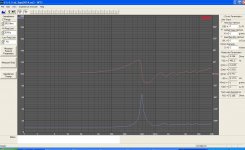We used to make a circuit like that which we discontinued in 1985. The problem with this driver was discussed earlier on this thread, to wit: even with hand-picked tubes, the circuit needs an AC balance means. The best place to put that is in the cathode of the first tube (balance potentiometer). It turns out though that this is poor means of balancing the circuit- it introduces as many problems as it solves. At best, the circuit does not come close to the cascode voltage amplifier we use, which is why we use the latter 😀 Take it from one who has experience with this- avoid that direct-coupled cascade. Looks good on paper but its doesn't work!
Not AC balance: DC offset compensation. A nasty DC offset from the 1st stage could put the second into a nonlinear part of its characteristic, if not cause one side to attempt to go to the DC rail and lock up. At least they're not DC coupling straight through, and have capacitor coupling to the grids of the finals.
The design above looks very much like a solid state design.(Si-Lver Fox) You can DC couple differential stages like that when using transistors since SS transistors don't age and deteriorate, so DC offset pots are set 'em and forget 'em. Been using the prototype for the Si-Lver Fox for years now and the DC offset hasn't changed at all, let alone drift into voice coil roasting territory.
A hollow state OTL that's DC coupled from input to output is a really bad idea, unless you include some sort of DC detection/protection for the speeks, or you include a servo to track and minimize DC offset.
Hi,
Even then it's still a bad idea as everything will then rely on the servo circuit to protect the speakers.
Most commercial OTL amps cut too many corners IMHO. Ralph's design is pretty darn good.
Maybe we should we ought compiles a list of dos and donts regarding OTL design as they really suffer a bad rep for no good reason and IMHO they can be the best amps with some speakers.
Obviously they'll never be cheap. Either to build or to run but they can really transport you into the recording studio given the right material.
Oh, regarding a low wattage OTL design? Hardly possible as you inevitably want low Zout. And that means either piling up lots of tubes or using high impedance (fragile that) speakers.
I'm talking PP OTL here as IMHO anything SE is for the euphony fans which I'm not.
Not that you can't design a neutral SE amp but that's another chapter.
Cheers, 😉
A hollow state OTL that's DC coupled from input to output is a really bad idea, unless you include some sort of DC detection/protection for the speeks, or you include a servo to track and minimize DC offset.
Even then it's still a bad idea as everything will then rely on the servo circuit to protect the speakers.
Most commercial OTL amps cut too many corners IMHO. Ralph's design is pretty darn good.
Maybe we should we ought compiles a list of dos and donts regarding OTL design as they really suffer a bad rep for no good reason and IMHO they can be the best amps with some speakers.
Obviously they'll never be cheap. Either to build or to run but they can really transport you into the recording studio given the right material.
Oh, regarding a low wattage OTL design? Hardly possible as you inevitably want low Zout. And that means either piling up lots of tubes or using high impedance (fragile that) speakers.
I'm talking PP OTL here as IMHO anything SE is for the euphony fans which I'm not.
Not that you can't design a neutral SE amp but that's another chapter.
Cheers, 😉
Here is the horn mid/tweeter driver impedance that the OTL will see. That is if I build one and only if this is a good match. I am running 4 way active horns so there is no passive crossover. Does this look good for an OTL?
As mentioned the crossover is active 6db/octave at 2kHz.
As mentioned the crossover is active 6db/octave at 2kHz.
Attachments
Without a fuse on the tube, the arc can sound like a grenade. We find that 1.5 amp slow blow will do the job- its more current than the tube will see in service but if the tube develops an arc or a short, the fuse will blow quite readily.
thanks for the info: will a small 5x20mm fuse do - or will it arc as well?
I am interested in this thread as my current loudspeaker has 6x 8R woofers per side, and I slowly started an OTL to drive this 48R load.
thanks for the info: will a small 5x20mm fuse do - or will it arc as well?
It will be fine.
Here is the horn mid/tweeter driver impedance that the OTL will see. That is if I build one and only if this is a good match. I am running 4 way active horns so there is no passive crossover. Does this look good for an OTL?
As mentioned the crossover is active 6db/octave at 2kHz.
Since you won't have any intense power demands and since you have an active crossover this should be fine. I would consider putting a capacitor in series with the load, as a tube arc driving higher frequency drivers like this could do some damage.
Not AC balance: DC offset compensation.
Right!... its a bit of both really. But more DC than AC. When we went to the cascode circuit we got lower distortion, similar gain and bandwidth, with no need for adjustment.
- Status
- Not open for further replies.
